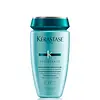What's inside
What's inside
 Benefits
Benefits

 Concerns
Concerns

 Ingredients Side-by-side
Ingredients Side-by-side

Water
Skin ConditioningSodium Laureth Sulfate
CleansingDisodium Cocoamphodiacetate
CleansingGlycol Distearate
EmollientSodium Laureth-8 Sulfate
CleansingHexylene Glycol
EmulsifyingSodium Chloride
MaskingSodium Benzoate
MaskingSodium Methylparaben
PreservativeMagnesium Laureth-8 Sulfate
CleansingMagnesium Laureth Sulfate
CleansingSodium Oleth Sulfate
CleansingHydroxypropyl Guar Hydroxypropyltrimonium Chloride
Alcohol Denat.
AntimicrobialPolyquaternium-30
Salicylic Acid
MaskingEthylparaben
PreservativeCarbomer
Emulsion StabilisingMagnesium Oleth Sulfate
CleansingAmyl Cinnamal
PerfumingBenzyl Alcohol
PerfumingHexyl Cinnamal
PerfumingMethylparaben
PreservativeLinalool
PerfumingBenzyl Salicylate
Perfuming2-Oleamido-1,3-Octadecanediol
Skin ConditioningLimonene
PerfumingCitronellol
PerfumingCetyl Alcohol
EmollientGlycerin
HumectantBehentrimonium Methosulfate
Quaternium-33
Trehalose
HumectantTamarindus Indica Seed Polysaccharide
Skin ConditioningMyrothamnus Flabellifolia Leaf Extract
EmollientCitric Acid
BufferingSodium Hydroxide
BufferingParfum
MaskingWater, Sodium Laureth Sulfate, Disodium Cocoamphodiacetate, Glycol Distearate, Sodium Laureth-8 Sulfate, Hexylene Glycol, Sodium Chloride, Sodium Benzoate, Sodium Methylparaben, Magnesium Laureth-8 Sulfate, Magnesium Laureth Sulfate, Sodium Oleth Sulfate, Hydroxypropyl Guar Hydroxypropyltrimonium Chloride, Alcohol Denat., Polyquaternium-30, Salicylic Acid, Ethylparaben, Carbomer, Magnesium Oleth Sulfate, Amyl Cinnamal, Benzyl Alcohol, Hexyl Cinnamal, Methylparaben, Linalool, Benzyl Salicylate, 2-Oleamido-1,3-Octadecanediol, Limonene, Citronellol, Cetyl Alcohol, Glycerin, Behentrimonium Methosulfate, Quaternium-33, Trehalose, Tamarindus Indica Seed Polysaccharide, Myrothamnus Flabellifolia Leaf Extract, Citric Acid, Sodium Hydroxide, Parfum
 Reviews
Reviews

Ingredients Explained
These ingredients are found in both products.
Ingredients higher up in an ingredient list are typically present in a larger amount.
Parfum is a catch-all term for an ingredient or more that is used to give a scent to products.
Also called "fragrance", this ingredient can be a blend of hundreds of chemicals or plant oils. This means every product with "fragrance" or "parfum" in the ingredients list is a different mixture.
For instance, Habanolide is a proprietary trade name for a specific aroma chemical. When used as a fragrance ingredient in cosmetics, most aroma chemicals fall under the broad labeling category of “FRAGRANCE” or “PARFUM” according to EU and US regulations.
The term 'parfum' or 'fragrance' is not regulated in many countries. In many cases, it is up to the brand to define this term.
For instance, many brands choose to label themselves as "fragrance-free" because they are not using synthetic fragrances. However, their products may still contain ingredients such as essential oils that are considered a fragrance by INCI standards.
One example is Calendula flower extract. Calendula is an essential oil that still imparts a scent or 'fragrance'.
Depending on the blend, the ingredients in the mixture can cause allergies and sensitivities on the skin. Some ingredients that are known EU allergens include linalool and citronellol.
Parfum can also be used to mask or cover an unpleasant scent.
The bottom line is: not all fragrances/parfum/ingredients are created equally. If you are worried about fragrances, we recommend taking a closer look at an ingredient. And of course, we always recommend speaking with a professional.
Learn more about ParfumChances are, you eat sodium chloride every day. Sodium Chloride is also known as table salt.
This ingredient has many purposes in skincare: thickener, emulsifier, and exfoliator.
You'll most likely find this ingredient in cleansers where it is used to create a gel-like texture. As an emulsifier, it also prevents ingredients from separating.
There is much debate on whether this ingredient is comedogenic. The short answer - comedogenic ratings don't tell the whole story. Learn more about comegodenic ratings here.
The concensus about this ingredient causing acne seems to be divided. Research is needed to understand if this ingredient does cause acne.
Scrubs may use salt as the primary exfoliating ingredient.
Learn more about Sodium ChlorideSodium Hydroxide is also known as lye or caustic soda. It is used to adjust the pH of products; many ingredients require a specific pH to be effective.
In small amounts, sodium hydroxide is considered safe to use. However, large amounts may cause chemical burns due to its high alkaline.
Your skin has a natural pH and acid mantle. This acid mantle helps prevent harmful bacteria from breaking through. The acid mantle also helps keep your skin hydrated.
"Alkaline" refers to a high pH level. A low pH level would be considered acidic.
Learn more about Sodium HydroxideWater. It's the most common cosmetic ingredient of all. You'll usually see it at the top of ingredient lists, meaning that it makes up the largest part of the product.
So why is it so popular? Water most often acts as a solvent - this means that it helps dissolve other ingredients into the formulation.
You'll also recognize water as that liquid we all need to stay alive. If you see this, drink a glass of water. Stay hydrated!
Learn more about Water